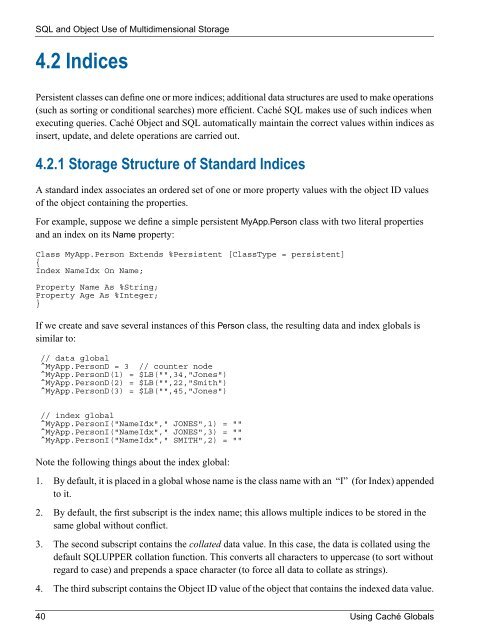Using Caché Globals - InterSystems Documentation
Using Caché Globals - InterSystems Documentation
Using Caché Globals - InterSystems Documentation
You also want an ePaper? Increase the reach of your titles
YUMPU automatically turns print PDFs into web optimized ePapers that Google loves.
SQL and Object Use of Multidimensional Storage4.2 IndicesPersistent classes can define one or more indices; additional data structures are used to make operations(such as sorting or conditional searches) more efficient. <strong>Caché</strong> SQL makes use of such indices whenexecuting queries. <strong>Caché</strong> Object and SQL automatically maintain the correct values within indices asinsert, update, and delete operations are carried out.4.2.1 Storage Structure of Standard IndicesA standard index associates an ordered set of one or more property values with the object ID valuesof the object containing the properties.For example, suppose we define a simple persistent MyApp.Person class with two literal propertiesand an index on its Name property:Class MyApp.Person Extends %Persistent [ClassType = persistent]{Index NameIdx On Name;Property Name As %String;Property Age As %Integer;}If we create and save several instances of this Person class, the resulting data and index globals issimilar to:// data global^MyApp.PersonD = 3 // counter node^MyApp.PersonD(1) = $LB("",34,"Jones")^MyApp.PersonD(2) = $LB("",22,"Smith")^MyApp.PersonD(3) = $LB("",45,"Jones")// index global^MyApp.PersonI("NameIdx"," JONES",1) = ""^MyApp.PersonI("NameIdx"," JONES",3) = ""^MyApp.PersonI("NameIdx"," SMITH",2) = ""Note the following things about the index global:1. By default, it is placed in a global whose name is the class name with an “I” (for Index) appendedto it.2. By default, the first subscript is the index name; this allows multiple indices to be stored in thesame global without conflict.3. The second subscript contains the collated data value. In this case, the data is collated using thedefault SQLUPPER collation function. This converts all characters to uppercase (to sort withoutregard to case) and prepends a space character (to force all data to collate as strings).4. The third subscript contains the Object ID value of the object that contains the indexed data value.40 <strong>Using</strong> <strong>Caché</strong> <strong>Globals</strong>

















